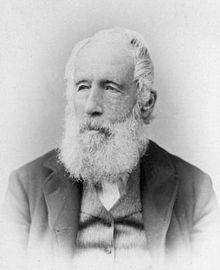John Bennet Lawes
Sir John Bennet Lawes, Bt | |
|---|---|
 | |
| Born | 28 December 1814 Harpenden, Hertfordshire, England |
| Died | 31 August 1900 (aged 85) |
| Awards | Albert Medal (1893) |

Sir John Bennet Lawes, 1st Baronet, FRS (28 December 1814 – 31 August 1900) was an English entrepreneur and agricultural scientist.[1] He founded an experimental farm at his home at Rothamsted Manor that eventually became Rothamsted Research, where he developed a superphosphate that would mark the beginnings of the chemical fertilizer industry.[citation needed]
Life[edit]
John Bennet Lawes was born at Rothamsted, Harpenden, Hertfordshire, on 28 December 1814,[2] the only son of John Bennet Lawes,[3] owner of the Rothamsted estate and lord of the manor of Rothamsted.[citation needed] His father died when he was eight years old, so he was brought up mostly by his mother Marianne.[2] He was educated at Eton College and Brasenose College, Oxford, although he didn't graduate.[citation needed] In 1822 , his father died and Lawes inherited Rothamsted.
Before leaving Oxford in 1832, Lawes had begun to interest himself in growing various medicinal plants on the Estates and started to experiment on the effects of various manures on plants growing in pots. A year or two later the experiments were extended to crops in the field in order to free farmers from relying on animals to produce fertilizer.[citation needed] In 1839, an ostrich belonging to him escaped Rothamsted and caused a bit of property damage, although the only person it hurt was the first one to try and capture it.[4]
In 1842, he patented a manure formed by treating phosphates with sulphuric acid, and thus initiated the artificial manure industry.[1] In the succeeding year he enlisted the services of Joseph Henry Gilbert, with whom he experimented for more than half a century in raising crops and feeding animals,[1] activities which have rendered Rothamsted famous to scientific agriculturists.[5] In 1854, he was elected a Fellow of the Royal Society, which in 1867 bestowed a Royal Medal on Lawes and Gilbert jointly,[citation needed] and in 1882 he was awarded the title of baronet.[6] He was elected as a member to the American Philosophical Society in 1883.[7]
Lawes died on 31 August 1900 and Rothamsted Manor and Estates passed to his son Charles. He was buried in the churchyard of St Nicholas Church, Harpenden with his wife Caroline (née Fountaine), who predeceased him (1822- 29 November 1895). They had two children, Caroline Lawes & Charles Bennet Lawes (3 October 1843 - 6 October 1911) Charles married Maria Amelia Rose Fountaine (related?) on 8 April 1869 at St George's Church, Hanover Square, London. He became Sir Charles Bennet Lawes-Wittewronge 2nd Bt on the death of his father in 1900 (the name Witteronge was his grandmother's maiden name)

Legacy[edit]
In 1889, Lawes took measures to ensure the continued existence of the Rothamsted experimental farm by setting aside money solely for that purpose and so established The Lawes Agricultural Trust.[1] Rothamsted Experimental Station is the oldest agricultural research facility in the world.[2]
Sir John Lawes School in Harpenden, Herts is named after him.[5]
The locality of Lawes, Queensland, in Australia is named after him. The main feature of that locality is the University of Queensland Gatton Campus which specialises in agriculture.[8]
References[edit]
- ^ a b c d "Sir John Bennet Lawes". Columbia University Press. Retrieved 22 May 2014.
- ^ a b c Holden, Margaret. "A Brief History of Rothamsted Experimental Station from 1843 to 1901". Community Sites. Retrieved 26 May 2014.
- ^ "John Bennet Lawes". Ancestry.com. Retrieved 22 May 2014.
- ^ "John Bennet LAWES jn – ornithologist?". Community Sites (originally in the Morning Chronicle). 18 February 1839. Retrieved 26 May 2014.
- ^ a b "School history". Sir John Lawes School & Chris Wright Systems. Retrieved 26 May 2014.
- ^ Anonymous (6 March 1989). "The Story of the Manor of Rothamsted". IACR Rothamsted Experimental Station. Retrieved 26 May 2014.
- ^ "APS Member History". search.amphilsoc.org. Retrieved 19 May 2021.
- ^ "Lawes (entry 44970)". Queensland Place Names. Queensland Government. Retrieved 6 November 2014.
- This article incorporates text from a publication now in the public domain: Chisholm, Hugh, ed. (1911). "Lawes, Sir John Bennet". Encyclopædia Britannica. Vol. 16 (11th ed.). Cambridge University Press. p. 300.
- Antonio Saltini, Storia delle scienze agrarie, vol. III, L'età della macchina a vapore e dei concimi industriali, Edagricole, Bologna 1989, 67–97
Further reading[edit]
- Dyke, G.V. John Bennet Lawes: the record of his genius. Taunton, Research Studies Pr.,1991, 482p.
- Dyke, G.V. John Lawes of Rothamsted: pioneer of science, farming and industry. Harpenden, Hoos Press, 1993, 234p.
